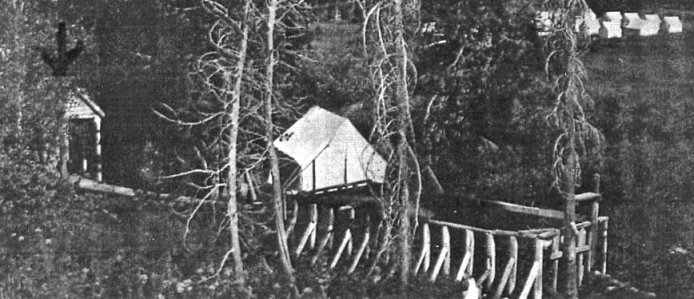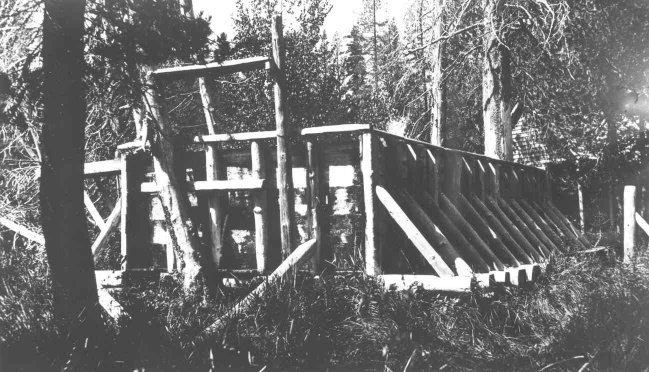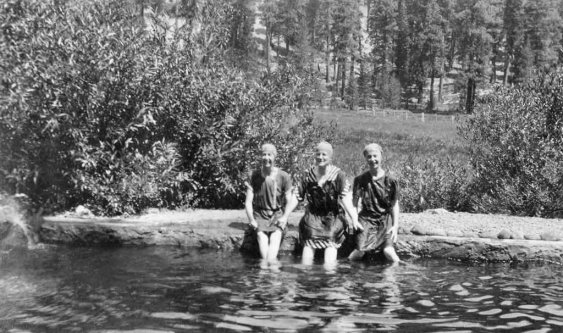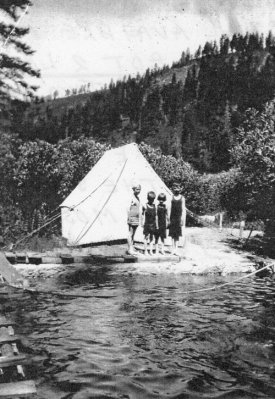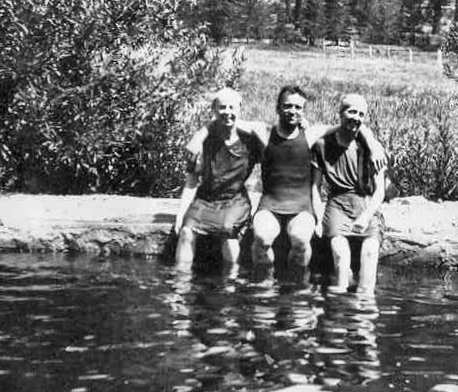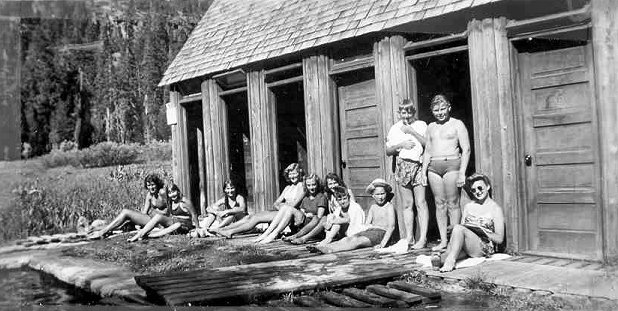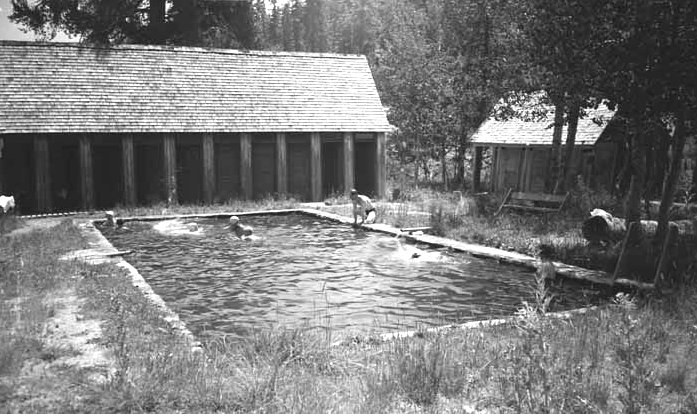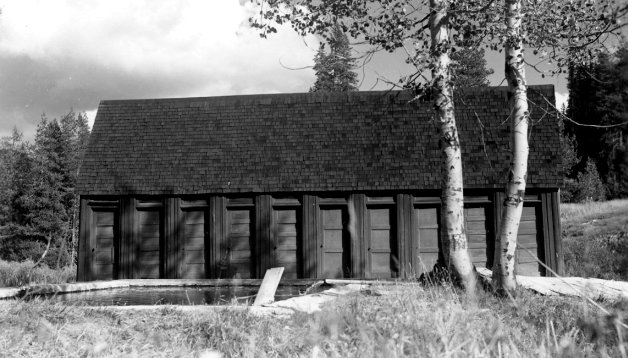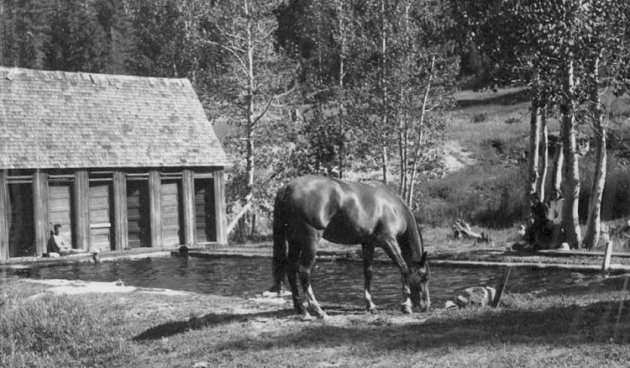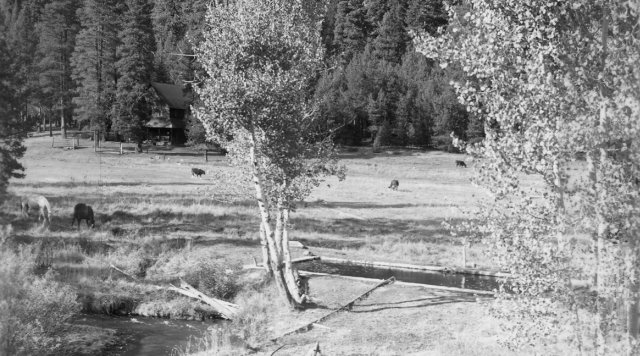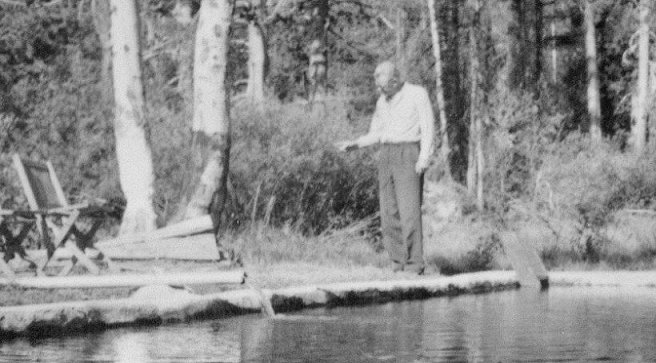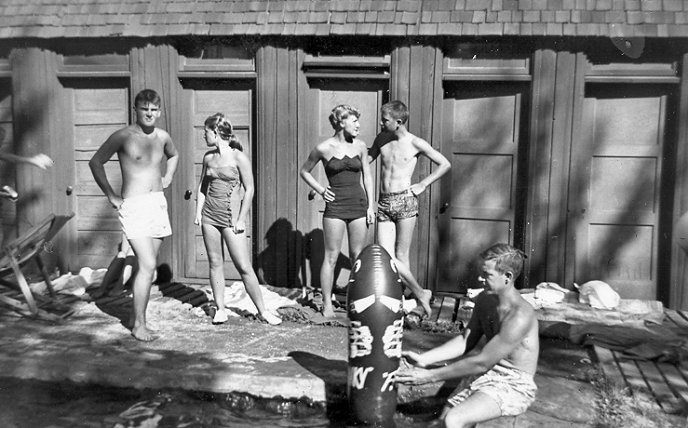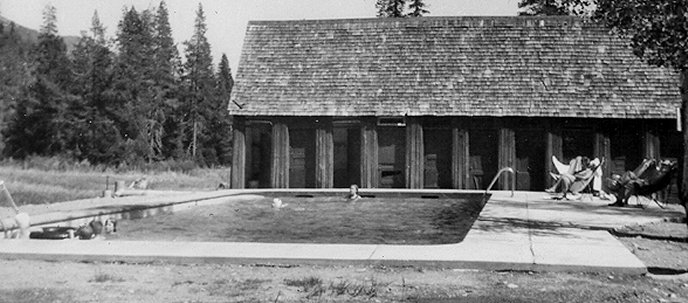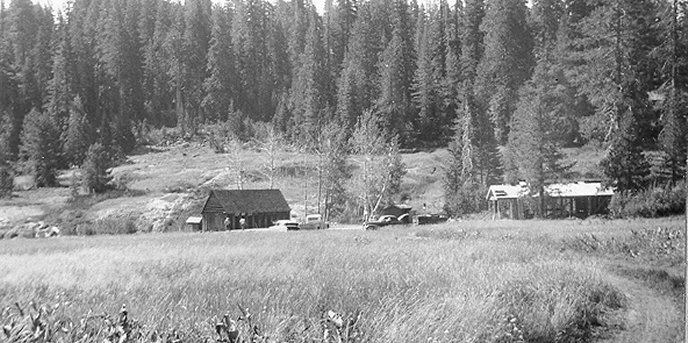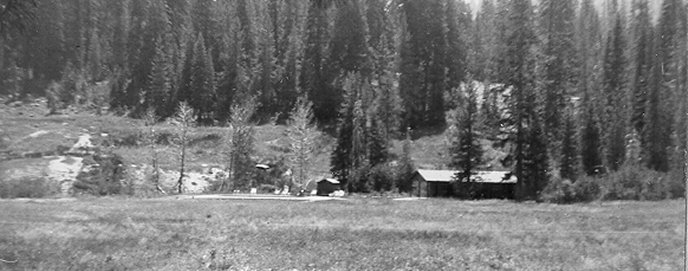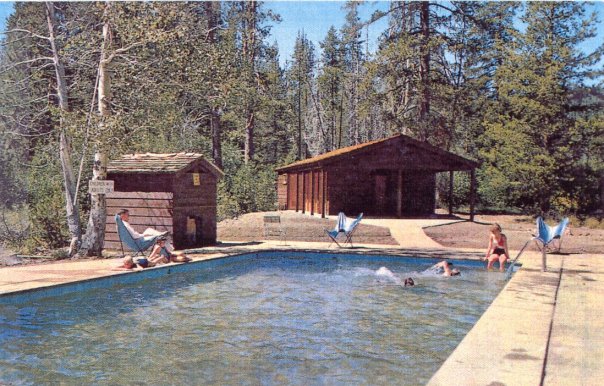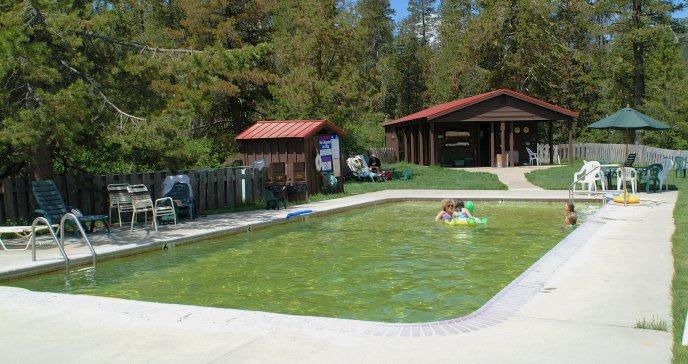Continuity and Change:
|
|
From Tub to Pool: The Evolution of Hot Water Bathing at Drakesbad For more than 100 years visitors have come to the remote Drakesbad Valley in the shadow of the Lassen volcano to take comfort in the soothing waters of the valley's hot mineral springs. Bathing in the thermal waters has always been a main attraction at Drakesbad whose very name "Drakesbad" is derived from the German "Drake's Baths". One of the earliest structures in the valley was a bath house into which naturally heated water was piped by means of a hollowed-out log. Even today there is no better place to ease the aches of a day on the trail than a good soak in the Drakesbad pool. The following traces the evolution of bathing facilities in the valley.
The first description of the bath house built by
Edward Drake sometime prior to 1900 comes from Roy Sifford who tells
us, "Drake had been there [Hot Spring Valley] since '87 had a log
cabin, built a bath house and built a good, new log cabin of some size
Roy Sifford dates the construction of this second bath house to 1896 (Sifford Manuscript: 4c.) and describes it in some detail: "It was built close to the north side of the stream. It was made of hand hewn timbers, split cedar shakes and square iron nails. There were no metal pipes or fittings of any kind. There were four separate rooms and four wooden tubs of normal size, made from sugar pine boards hauled from Greenville by Drake. The hot water was brought down in a ditch that crossed the creek, by using a forty foot hollowed out tamarack pole. The hot water flowed through a large hollowed out long pole which extended along the back of the bath house, about 22 feet. This large pole was the 'hot water tank.' It sat there full of hot water all the time. The sugar pine tubs stood against the south wall on the outside. A little sluice box came through the wall and to get the hot water you pulled the stopper and the hot water poured in abundance!" (Sifford 1994:9) Roy Sifford recalled Drake's bath house as "a comfortable and good bath house" and in high demand: "even in those days there were often a 100 or so people camped with their teams and wagons and horses and they took their trips around the surrounding area and came back always three, four, five o'clock looking for their daily hot bath. Of course, not many of them could get into those four rooms and they would sit for two or three hours waiting for their turn at the bath." Bath with a towel cost $.25 (Roy Sifford interviewed by Les Bodine n.d.). As Roy Sifford later recalled, "It was a mighty fine thing for them. Twenty-five cents for a bath with a towel. That was a pretty good deal. There was nothing like it in the country" (Sifford Manuscript:120b)
If Roy Sifford is correct, the four-room bath house in place in 1900 was the second such structure built by Edward Drake. There is no information concerning the first structure.
In 1902, in an effort to improve access to the hot water, the Siffords excavated a 40' by 20' and 4' deep "swimming pool" just east of Drakes bath house, using a team of mules and a scraper. Roy Sifford recalled that "we did get a pool fairly warm and fine as long as nobody stirred it up." However, the nature of the local volcanic soils was such that even a few swimmers "thrashing about" in the water turned the pool into an unsightly "mud bath". (Sifford 5/19/85 letter to Richard Vance LAVO Files). Note: In an interview with Les Bodine n.d. Roy Sifford describes the pool as "70 feet long, 30 feet wide and about 4 to 5 feet deep, and that the pool was started in 1901 and completed in 1902". However, elsewhere he gives 1903 as the date of construction of the earthen pool (Sifford 1994: 25-26).
The next attempt at an improved swimming facility was the construction of an above-ground "wooden plunge" in 1903-04. The Sifford family began hewing timbers for the plunge in 1903, and in the spring of 1904 hauled boards from the Odette Mill in Susanville to Drakesbad for use in the construction of the plunge floor and sides. When completed the wooden plunge was 36 feet long, 18 feet wide, and 5 feet deep (Sifford 5/19/85 letter to Richard Vance LAVO Files). Finished and opened to the public in 1905, this plunge was used by "thousands" of bathers from 1905 until 1914. Note: In the Bodine interviews Roy Sifford describes the wooden plunge as "32 feet long, 24 feet wide".
In 1914 the wooden plunge was replaced by an in-ground "rock and concrete plunge", 42 feet by 22 feet with a depth ranging from 3 to 5 1/2 feet. Rock for the pool was hauled from Flat Iron Ridge to the pool site where a stone mason from Susanville constructed "a very nice rock plunge" (Roy Sifford interviewed by Les Bodine n.d.). Roy Sifford describes this rock and concrete plunge as the center of "Hot Water activity" and "hundred and hundred of Baths and Swims went on there". To accommodate the bathers both Drakes original bath house and tent dressing rooms were used. (Sifford 5/19/85 letter to Richard Vance LAVO Files).
In 1920 Sifford says, "We built a new bath house to replace the old one of Mr. Drake" (Sifford 5/19/85 letter to Richard Vance LAVO Files). The new bath house was constructed of tamarack logs and consisted of eight bath rooms on the east side and ten dressing rooms on the west side facing the rock and concrete plunge. Sifford statement that the new bath house "replaced" the Drake bath house indicates that the latter structure was torn down. However the 1942 photograph above shows a second building which appears in size and construction to fit the description of Drakes Bath house. The photograph suggests that Drake's bath house, built some time prior to 1900, was not destroyed in 1920, but was still standing more than 20 years later. Unfortunately, the photograph above is the only one currently known to exist that clearly shows this building.
In the three photographs above the 1942 structure is on the left and the two photographs to the right are the only two confirmed photos of Drake's bath house built prior to 1900. The 1942 structure also appears to have four individual doors, a configuration which is consistent with Sifford's description of Drake's bath house. In later photographs this building is missing and appears to have collapsed or been removed. Several of the photos below show what appear to the collapsed remnants of a small building. However, Susan Watson recalls a small out building in the same area in the late 1930s and it may be debris from the collapse of that building that is seen in later photographs (Watson: personal communication)
The rock and concrete plunge was used until about 1960 when the Park Service "built a new plunge which is right in the place where the old plunge was and they got rid of the old Drakesbad bathhouse and built other bath houses which are there" (Roy Sifford interviewed by Les Bodine n.d.).
After the 2021 Dixie Fire, the lodge pool suffered further damage from a flood in the fall of that year and had to be removed (plans are to rebuild it).
drakesbad/plunge.htm Last Updated: 09-Dec-2024 |
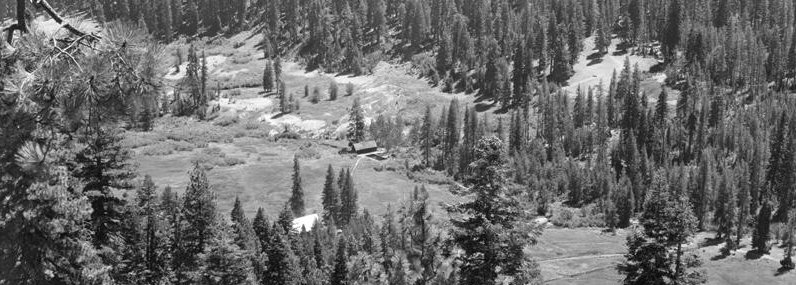
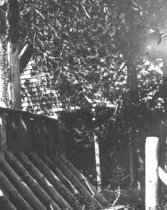 which was used for many
years for the office and headquarters. Later on, he had built a good,
four room bath house bringing the water which was hot to about 137°
down from the hot springs just to the south edge of the creek" (Roy
Sifford interviewed by Les Bodine n.d.). Drake's bath house was located
"about where the present Bath and Plunge are located now" (Sifford
5/19/85 letter to Richard Vance LAVO Files).
which was used for many
years for the office and headquarters. Later on, he had built a good,
four room bath house bringing the water which was hot to about 137°
down from the hot springs just to the south edge of the creek" (Roy
Sifford interviewed by Les Bodine n.d.). Drake's bath house was located
"about where the present Bath and Plunge are located now" (Sifford
5/19/85 letter to Richard Vance LAVO Files).